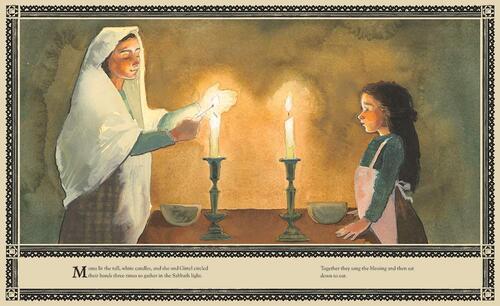A Passover Story: Lesléa Newman's "Gittel's Journey"
Lesléa Newman’s Gittel’s Journey: An Ellis Island Journey, published earlier this year, is a picture book gorgeously illustrated by Amy June Bates. It is ostensibly for children, and nowhere in the text is Passover explicitly mentioned. However, this immigration tale, based on a true story, overlaps with one of the central themes of Pesach: that having been strangers ourselves, we are ethically obligated to remember the stranger and to teach the next generation that sacred lesson.
At the outset of the book, nine-year old Gittel and her mother are tearfully preparing for their journey to America, and Gittel has to be told yet again that she must leave her pet goat, Frieda, behind. Gittel’s mother uses the lighting of Sabbath candles to provide some comfort and continuity for both herself and her daughter. However, when the two arrive at the European port the next day, such comfort is fleeting. Gittel’s mother is suspected of having an eye infection and she cannot board the boat. Knowing that “home is not safe,” she sends Gittel off on the journey alone, armed only with the Sabbath candlesticks and a piece of paper that contains the address of cousin Mendel, their sponsor in America.
Gittel follows her mother’s instructions to not lose that precious piece of paper. However, after a long, lonely, and fearful journey, she discovers that the ink on the paper has rubbed off on her hands and all traces of Mendel’s last name and address are gone. A “barking” and “scowling” immigration officer is offset by a kind interpreter who speaks Yiddish to her and sends her photo to the Jewish press, which enables Mendel to find and claim her. Her mother eventually arrives at Ellis Island. When she does, Gittel’s priority is to take her mother to their new home so that they can light the Sabbath candles together.
In an author’s note, Newman shares the history of the real Gittel, Sadie Gringrass. Sadie was the mother of Newman’s “aunt” Phyllis, and, like Gittel, traveled to America alone. Unlike Gittel, Sadie was never reunited with her mother—or her father, although she was able to serve as a sponsor for one of her younger sisters. Newman also tells the story of her beloved grandmother, Ruth Levin, who gave Newman one of the only possessions Levin’s mother brought from the “Old Country,” a pair of Sabbath candlesticks. A photo of those candlesticks is included, taken by Newman’s spouse, Mary Vazquez.
Newman uses details from the personal histories of her own kin to teach children—and likely some of the adults who will read this book to the children in their lives—a bit of immigration history. Gittel’s Journey is an age-appropriate vehicle for imparting lessons about the wave of Jewish immigration from Eastern Europe that began in the 1880s and diminished to a trickle due to the restrictive quotas imposed by the Immigration Act of 1924. Many 3rd and 4th generation Jewish Americans will likely find a bit of their own family history in Gittel’s story.
However, as Newman reminds us in her author’s note, the overarching themes and narrative of Gittel’s Journey are not just the stuff of history: “To this day, thousands of people, including many children traveling alone, immigrate to America each year in search of a better life and a safe place to call home.” In an essay written for the Jewish Book Council, Newman explains that a photo of Syrian refugees awakened her own memory of Sadie’s story and was the catalyst for Gittel’s Journey.
We are living in a moment when children are forcibly separated from their parents at the U.S. border and housed in cages, when immigrants, refugees, and asylum seekers are demonized by white nationalists, some of whom have found a home in our government. We must mobilize our tradition, our history, and our individual stories to resist this xenophobic zeitgeist and to sustain ourselves. The epic Exodus story primes us for such political and spiritual work. However, we should not underestimate the subtle power of—and need for—smaller scale stories like Gittel’s Journey.








